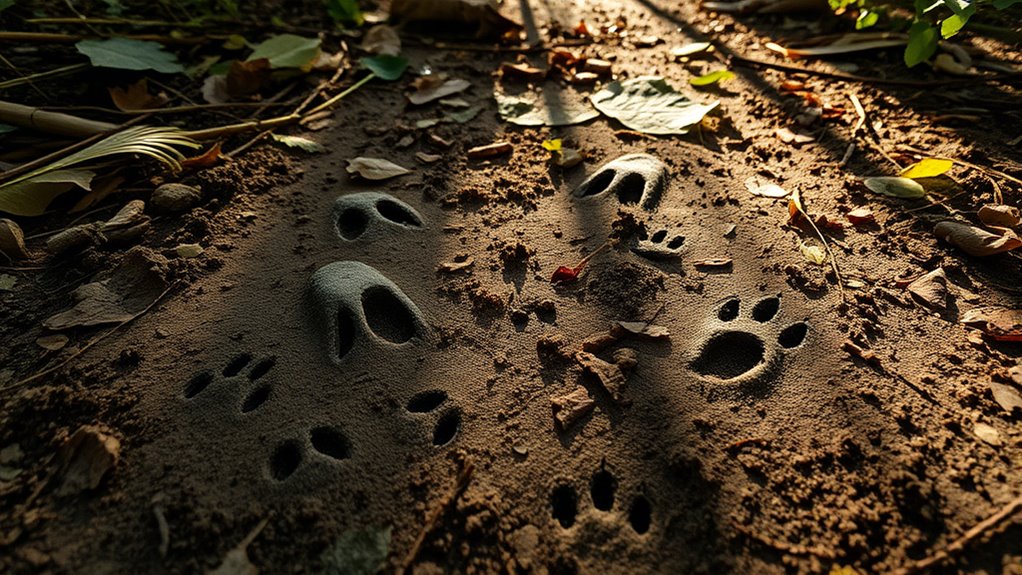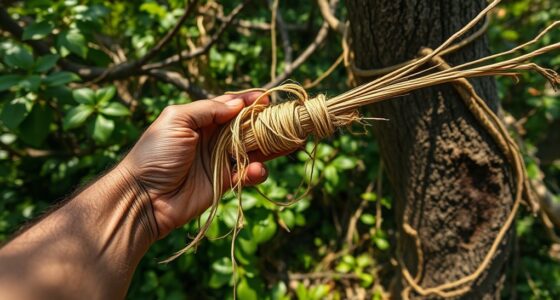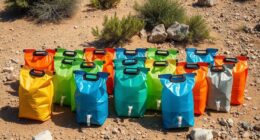Examining animal tracks and signs helps you understand how creatures move, hunt, and survive in their habitats. By recognizing patterns, such as gait, shape, and size, you can identify different species and their behaviors. Clues like scat, trail marks, and habitat context offer insight into their ecological roles. Using field guides and tracking tools sharpens your skills. Keep exploring to uncover more about these fascinating signals from nature’s foragers.
Key Takeaways
- Observing track patterns, such as gait and stride, reveals foraging behavior and movement strategies of wild animals.
- Differentiating hoofed and canine or feline tracks helps identify specific foragers and their dietary habits.
- Analyzing scat provides insights into what animals are eating and their role in the ecosystem.
- Environmental conditions influence the clarity and details of tracks, aiding in understanding foraging areas and activity times.
- Tracking signs supports conservation by revealing habitat use, population presence, and foraging patterns of wild species.
Recognizing Track Patterns in the Wild

Recognizing track patterns in the wild requires paying close attention to the unique features of animal footprints and the environments where they’re found. You’ll notice that carnivores often have varying gaits like walking, trotting, loping, or bounding, depending on their activity. Typically, their front footprints are larger than the hind ones, and their stride length can be quite different—for example, a coyote’s stride ranges from about 24 to 38 inches. The track orientation also gives clues; coyote tracks tend to slant forward, with toes pressing deeper than the palm. Habitat clues help too: tracks appear in forests or grasslands, showing how animals adapt to different environments. By observing these details, you can identify carnivore activity and understand their movement patterns. Paying attention to eco-friendly practices can also inform you about the sustainability of the environment where the tracks are found. Additionally, understanding local wildlife populations can enhance your ability to interpret various animal signs accurately. Informed observation of these signs can also assist in conservation efforts, ensuring that ecosystems remain balanced and healthy.
Differentiating Hoofed Animal Tracks

When examining hoofed animal tracks, paying attention to their distinctive split hooves is key to telling species apart. The shape of the print varies; some form a heart, while others are round or square.
Size also helps—moose tracks are large, heart-shaped, and measure 5-7 inches, often with dew claw marks. Deer tracks are smaller, more symmetrical, with a narrow split hoof. Elk tracks are broader and more rounded, larger than deer but smaller than moose. Cattle tracks tend to be bigger, wider, and more rounded.
Ground conditions, weight, and movement influence track appearance—softer ground creates deeper impressions, and faster movement produces lighter prints. Recognizing these differences enables you to distinguish hoofed species accurately in the wild.
Identifying Canine and Feline Footprints

Canine and feline footprints can be distinguished by examining key features such as claw marks, toe shape, and pad structure.
Canines usually leave claw marks because they don’t retract their claws, while felines often don’t, making claw marks rare in their tracks.
Canine toes are symmetrical and blocky, with a triangular metacarpal pad that has a single lobe at the top, creating a compact track.
Feline toes are teardrop-shaped and asymmetrical, with retractable claws often hidden.
Track size varies with species; wolves are larger than foxes, but overlaps occur.
Domestic dog tracks may appear splayed due to obesity.
Always consider environmental factors, such as terrain and moisture, which can alter track appearance and clarity, affecting your identification accuracy.
Interpreting Mammal Scat and Other Signs

Interpreting mammal scat and other signs requires careful observation of physical characteristics, environmental context, and behavioral clues. Look at the shape, size, color, and texture to identify the species. For example, small, round pellets suggest rabbits, while larger, pellet-like droppings indicate deer.
Careful observation of scat shape, size, and environment helps identify mammal species and their habits.
Tubular scat with pointed ends and hair or bone fragments points to coyotes, whereas large, seed-filled cylinders are typical of bears. Note the location and habitat—scat often reveals an animal’s preferred environment. Recognizing these signs can also assist in understanding the habitat preferences of different species and their roles in the ecosystem. Incorporating environmental cues into your observations can improve accuracy and deepen ecological insights.
Smell can also help, as some scat has distinctive odors. Using field guides or digital apps enhances accuracy.
Analyzing scat reveals diet, nutrient sources, and health issues, offering insights into animal behavior, ecological roles, and conservation needs. Understanding pinball machine weights can assist in managing and relocating these devices, especially during repairs or home installation.
Observing Tracks in Snow, Mud, and Sand

Observing animal tracks in snow, mud, and sand offers valuable clues about wildlife movements and behavior. Snow provides clear impressions with minimal detail loss, making it easier to identify tracks. Footprint clarity is often better in snow, allowing for more precise identification. Mud captures detailed impressions, including toenails and footpad shapes, revealing species specifics. Sand can obscure details but is useful for tracking long-distance movements. Weather conditions like thawing or rain can alter the appearance of tracks, so timing matters. In snow, deer leave heart-shaped tracks in patterns indicating group travel, while fox and badger tracks can look similar—fox tracks are smaller. Mink prints are tiny and lack claws, unlike bird tracks that resemble arrowheads. Rabbit tracks are distinct and show recent activity. Paying attention to claw marks, toe arrangement, and track shape helps decipher which animal made the tracks. Additionally, understanding the behavior of animals when they leave tracks can provide insights into their habits and habitats. Incorporating animal tracking technologies can further enhance tracking accuracy and data collection. Recognizing environmental factors such as wind and terrain also plays a crucial role in accurate tracking and interpretation.
Using Track Size and Shape for Species Clues

Tracking animals often hinges on recognizing the distinct sizes and shapes of their footprints. You can use size as a key indicator: wolf tracks are about 4 inches long with four toes, often found in straight lines, while coyotes are smaller, around 3 inches, oval-shaped, and more elongated. Predictive analytics can help interpret these patterns by analyzing environmental data and footprint characteristics to improve species identification. Fox tracks are the smallest, 2 to 3 inches, sometimes showing drag marks and fur impressions. Ungulate tracks, like deer, are 2 to 3.5 inches with pointed impressions, whereas moose tracks are much larger, 5 to 7 inches, with a heart-like shape. Recognizing these differences helps you identify species at a glance. Claw marks also aid identification—visible in canines but usually absent in feline tracks. Shape and size together reveal a lot about the animal that made the footprint.
Analyzing Habitat and Terrain for Animal Habits

Understanding the terrain and habitat features where animals live is essential for predicting their behavior and movement patterns. Different habitats like forests, grasslands, and wetlands host specific species adapted through specialized behaviors and traits. Terrain analysis, including elevation, slope, and ruggedness, reveals how accessible areas are, influencing animal use. Rocky or steep terrains are usually avoided, while flatter regions promote movement and activity. Topographic features such as hills, valleys, and plains shape habitat preferences and migration routes. Using tools like GIS and spatial analysis helps you create detailed habitat maps, which are crucial for understanding animal distribution. Recognizing habitat heterogeneity and fragmentation allows you to anticipate how animals adapt, move, and respond to environmental changes, informing effective conservation strategies. Habitat features such as water sources, vegetation types, and shelter availability further influence animal distribution and behavior. Additionally, understanding animal movement patterns in relation to terrain features enables more accurate predictions of their habitat use and migration routes. Incorporating knowledge of pollution impacts and how they alter habitats can further refine habitat assessments and conservation planning. Studying animal foraging behavior provides insights into how animals utilize different terrain types to meet their dietary needs, which helps in habitat management. Moreover, terrain features can impact the availability of foraging opportunities, shaping the foraging strategies animals employ in various environments.
Employing Field Guides and Tracking Tools

Employing field guides and tracking tools enhances your ability to identify and analyze animal signs accurately in the field. Use guides like Roger Tory Peterson’s system or regional resources tailored to your area, such as the Eastern Woodlands or Western Mountains. Digital apps offer quick identification, GPS tagging, and high-resolution images, making tracking more efficient. Compact pocket guides simplify references on the go, while specialized guides focus on insects, birds, or specific mammals. Tracking tools like apps—Tracking Pro or iTrack Wildlife—provide measurement features and extensive databases. GPS devices help map your observations, waterproof notebooks record details, and camera traps capture visual evidence. Combining these resources sharpens your skills, improves accuracy, and makes tracking more engaging and productive in any environment. Paying attention to animal tracks and signs can reveal behaviors and patterns that are not immediately obvious, greatly enriching your understanding of wildlife. Additionally, understanding self watering plant pots can be useful if you’re cultivating native plants for habitat restoration projects. Incorporating field guides with detailed illustrations and descriptions can further refine your identification process and deepen your connection to the natural world. Recognizing animal footprints and scat can also provide insights into species presence and activity levels in your area. Using tracking tools effectively can help you correlate signs with specific species and behaviors, enhancing your overall tracking skills.
The Role of Tracks in Wildlife Conservation
Using field guides and tracking tools not only sharpens your ability to identify animal signs but also plays a vital role in wildlife conservation. Tracks reveal which species are in an area, helping you understand their presence and habitat use.
Using tracking tools helps identify species and supports wildlife conservation efforts.
By analyzing footprints, conservationists estimate population sizes and monitor movement patterns, which are essential for protecting species. Tracks also indicate predator activity or threats, guiding threat assessments. Incorporating species-specific characteristics into your observations enhances the accuracy of your identifications.
Additionally, understanding animal tracks clarifies their ecological roles, supporting ecosystem management. This data informs the creation and management of protected areas, wildlife corridors, and habitat restoration efforts. Tracking techniques often involve understanding specific footprint characteristics, enabling more accurate identification of species even from partial or obscured prints.
When you track animals, you’re contributing valuable information that influences policies and conservation strategies. Your efforts help guarantee the survival of species and the health of ecosystems for future generations. Incorporating Glycolic Acid into skincare routines has shown benefits such as promoting clearer, more radiant skin, which can also encourage a deeper appreciation for the natural world and its diverse ecosystems. Understanding animal tracking techniques enhances your ability to gather meaningful data that supports conservation efforts, including species identification and habitat monitoring.
Enhancing Skills Through Community and Educational Programs
Participating in community and educational programs offers a powerful way to enhance your tracking skills while supporting wildlife conservation. Educational tools like Animal Tracks & Traces Teaching Kits provide lesson plans, activities, and games that make learning engaging. Digital resources, including downloadable lesson plans, help you study animal signs at your own pace. Nature preserves offer guides that teach you how to interpret tracks in natural settings. Interactive storytelling sessions deepen your understanding of animal movements, while structured curricula cover topics like track morphology and ecology. Community involvement through outdoor workshops, tracking events, and expert-led activities allows you to practice and share techniques. Mentorship programs and collaborative learning foster continuous skill development and help you connect with others passionate about tracking and conservation. Incorporating market research can help tailor your learning experiences to current trends and enhance your skills effectively.
Frequently Asked Questions
How Can I Tell if a Track Was Made by a Juvenile or Adult Animal?
To tell if a track was made by a juvenile or adult animal, look at the track size, shape, and pattern. Larger tracks usually belong to adults, while smaller ones are juveniles.
Check toe alignment, track depth, and deformation; juveniles often leave irregular, shallower tracks.
Also, observe environmental factors like substrate and weather, which can affect track clarity. Combining these clues helps you accurately identify the age of the animal.
What Signs Indicate an Animal Is Territorial Besides Tracks?
Imagine the animal’s territory as its personal kingdom, marked with signs for all to see. You’ll notice vivid visual displays like colorful postures, scent marks on vegetation, and distinctive vocal calls echoing its presence.
Sometimes, animals create physical barriers or raise tails to declare ownership. These signs act as silent sentinels, telling intruders to stay away, and reveal the animal’s fierce desire to protect its domain without a single fight.
How Does Weather Affect the Preservation of Animal Tracks?
Weather plays a vital role in preserving animal tracks. Hot temperatures dry out the soil, making tracks fade faster, while humidity helps keep them intact longer.
Heavy rain or floods wash away impressions quickly, and strong wind can blow debris over tracks, distorting them.
Snow can preserve tracks temporarily, but once it melts, the evidence disappears.
Tracking soon after favorable weather conditions gives you the best chance to observe and record animal activity.
Can Tracks Reveal an Animal’S Direction and Speed Accurately?
Did you know tracks can reveal an animal’s direction and speed with about 80% accuracy? You can analyze the orientation of footprints and the pattern of movement to determine direction.
Stride length and track pattern help estimate speed, while depth and clarity give clues about recent activity. With experience, you can interpret gait patterns and track details to understand how fast an animal is moving and where it’s heading.
What Are Common Mistakes Beginners Make When Tracking Animals?
When tracking animals, you often make mistakes like not preparing properly or lacking essential tools, which hinders accurate identification.
You might misinterpret tracks by rushing or ignoring context such as habitat or terrain. Overanalyzing single tracks or expecting quick results can create frustration.
Additionally, you may overlook the importance of understanding basic gaits, assuming tracks are from rare species, or not staying flexible in your interpretations.
This limits your learning and enjoyment.
Conclusion
As you become more skilled at reading animal tracks and signs, you’ll start noticing subtle clues others overlook. Every footprint, scrape, or scat paints a vivid picture of the wild creatures that share your environment. With each discovery, you’ll feel closer to nature’s secrets, wondering what stories lie hidden behind each sign. Keep exploring—because the next track you find could reveal a mystery waiting to be uncovered. The wild awaits your keen eye.










